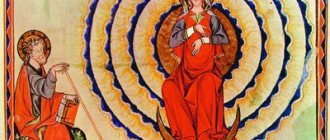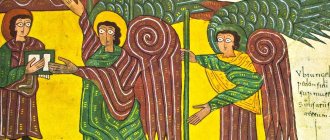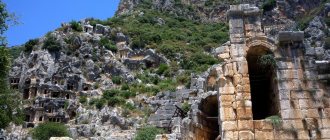Chapters II - III. Seven Churches
Revelation is addressed to the seven churches, which in so far is similar to the apostolic epistles in general. The latter are direct written appeals of the apostles to individual local communities or even individuals. They are thereby included within certain boundaries of space and time (only in some cases individual messages as “conciliar” have a less specific appeal, but this does not deprive them of historical certainty). What can be said in this regard about the seven churches to which Revelation is addressed, as well as about the special nature of this address? Of course, it also bears the stamp of history and archeology, which exegesis establishes to the best of its ability and with approximate accuracy. Ephesus, Smyrna, Sardis, Philadelphia, Laodicea are specific geographical and historical centers, which each have their own different religious and cultural character, their inherent specific weight in the history of the church. Their very choice can be considered, to a certain extent, as a historical accident, depending on the personal orientation of the sacred writer John. However, this does not eliminate its typological and mysterious meaning. At the same time, individual features of these churches are captured in poignant characteristics. Some interpreters also see in them symbols of successive historical eras, marked by corresponding features, although, of course, such an interpretation inevitably allows for arbitrariness and controversy. It is deprived of the key to their historical code; it remains hypothetical. According to the general dogmatic task of this essay, we prefer to completely abandon here the study of the character of the seven Asian churches in its historical concreteness; we are more interested in the religious-dogmatic character of these images as expressing in their totality a certain fullness of church-historical existence in its strengths and weaknesses. All individual addresses to the seven local churches speak about the Church itself, and it is not for nothing that each of them contains a significant appeal: “let him who has an ear hear what the Spirit says to the churches” (II, 7, 17, 29; III, 6, 13, 29) , i.e. in the person of their one Church of Christ.
33
In the general plan of this book, chapters II-III, dedicated to the seven churches, have only episodic significance; they are, so to speak, the recipients through which this wondrous message is sent to the entire Christian world, revealing the fate of the world in its history. It is noteworthy that the appeal to all seven Churches is made directly to their angels. It can refer both to their heavenly guardians - angels, who are inherent in local churches, 1) and to earthly primates - bishops. Both understandings are possible (however, the second also raises some doubts about the attitude towards the universality of episcopate in this era, which was definitely evidenced in history only from the 2nd century, i.e., after the composition of Revelation).
The Angel of the Church of Ephesus is pleased with her deeds and labor “for the name” of Christ, but most of all patience (II, 2-3), moreover, not only passive, consisting in enduring “many things,” but also active, expressed in distinguishing true apostleship from false ones. claims - and not an exhausting struggle for the truth and work for it. However, with this - somewhat unexpectedly - there is also a reproach for leaving “your first love” (4). Is it clear here that the first inspiration of love is a lofty gift that was inherent in the first church, but which was gradually lost by it, albeit in labors and struggle for the truth, or does this reproach apply, in some special sense, to the entire church of Ephesus? , or to the personal destinies of its individual members, it makes no difference - those guilty are called to repentance for the loss of the only, irreplaceable gift. However, along with this, the Ephesian Church is also credited with its opposition, “hatred” to the works of the Nicolaitans (whatever they may be), that is, to individual specific temptations of sensuality and sin. This spiritual state of the “overcomer” is rewarded by eating from the tree of life, standing in the middle of the paradise of God (Gen. II, 9), i.e., by the power of the special vitality inherent in man, which supports him after creation (isn’t it clear in this eating from the fruit of paradise, obviously spiritual, grace taught in the sacraments of the Church, in particular the Divine Eucharist?). This promise is spoken by Christ holding seven stars, walking in the midst of seven golden lamps, that is, His spirituality is deliberately demonstrated, which is expressed in the possession and sending of seven gifts of the Holy Spirit of the Comforter, therefore, the gracious nature of the Church of Christ is testified. The seer himself and
1) Wed. “Jacob’s Ladder”, a chapter about Guardian Angels, given not only to each individual, but also to human societies, peoples, and in particular their religious associations.
34
as the compiler of the fourth Gospel, the most spiritual, is associated by tradition with the name of Ephesus, which is called in this first address to the seven churches.
In the appeal to the Angel of the Church of Smyrna, Christian martyrdom and long-suffering, “works and sorrow and poverty” (9), which, however, is united with the only true spiritual wealth (“however, you are rich”) are blessed. Particular mention is made of slander from the “Jews,” who in reality are “not like that, but a synagogue of Satan.” Therefore, here we can understand not the Jewish, but in general the anti-Christian persecution, which will be expressed in the fact that the devil (the true inspirer of the persecution) “will cast you from among you into prison to tempt you” (II, 10), even if only temporarily, not completely victorious grief (“ten days”, obviously symbolic). Believers are called to “faithfulness unto death,” that is, martyrdom for Christ, which promises a “crown of life,” obviously in the next century. Naturally, such a promise is given by Christ as “the First and the Last,” who “was dead and is alive,” risen and resurrector. He “by His Spirit” says to the churches: “he who overcomes will not suffer harm from the second death” (which will be discussed below, XXI, 8). So, the church is historically and spiritually called to be ready for martyrdom and to be undaunted by it (cf. Matt. XVI, 17-18).
This general call is confirmed in relation to the Pergamon church, through the foreshadowing of the special strength and burden of the tests of faith manifested here (and therefore, its greatest strength, manifested in the killing of “My faithful witness Antipas”); whoever this Antipas may be historically, which we don’t know exactly, but this name can also be accepted as a common noun, a generic one for similar tests, in which we are talking about the last tests of faith (“you will keep My Name and have not renounced the faith” II, 13). Naturally, this revelation comes from Christ as having a two-edged sword (II, 12); this is a sign of the conquering truth. However, even the exceptional firmness in the faith of some does not eliminate, along with this, the possibility of temptations for others in the same environment: here they are called “those who hold the teachings of Balaam,” “who taught Balak” (Num. XXII, 24), a not entirely clear hint to this historical episode, and are again called “those who adhere to the teachings of the Nicolaitans.” Under this general name can be understood various false teachings, both religious-mystical and occult, according to the special spiritual looseness characteristic of this place (“where Satan lives”).
In view of such spiritual aggravation, characteristic of one
35
and to the same place, or historical era, the Lord gives a special promise: “I will soon come to you and fight with them with the sword of My mouth”: this means that where the greatest tension of the struggle is, there is the grace-filled proximity and help of Christ. “I will soon come to you and fight with them with the sword of My mouth” (II, 16). 1) According to this general deepening of the struggle and intensification of the religious process in history, which we are witnessing in our days, new, mysterious promises of help and reward are given by the Holy Spirit; “I gave to the one who overcomes the hidden manna (some new spiritual powers) to eat, and I will give him a white stone (a symbol of purity and firmness), and on the stone was written a new name, which no one knows except the one who receives” (II, 17). This is how the idea of a special mysterious revelation is expressed, containing a “new name”, which will be named in the next century, and perhaps even in the present one will be given to those worthy of it. In any case, it is obvious that this mysterious fact, testified by Revelation, does not find external evidence for itself in history. It remains a mystery of personal revelation.
The angel of the Thyatira church is written about the revelation of the “Son of God” who appeared in His majesty, “whose eyes are like a flame of fire and whose feet are like halkolivan,” He speaks as a judge who has authority and weighs “your works, your love and service, and your faith, and your patience, and that your last deeds are greater than your first” (II, 18-19). Apparently, this is not about private exploits and temptations, but about the outcome and work of a lifetime. Special temptations here come through the false prophetess Jezebel, who teaches to commit fornication and eat things sacrificed to idols” (20). We do not have the data to decipher this historical symbol by attributing it to a specific place, time and event. Apparently, what is meant here is the temptation of a false civilization (that which below takes the form of Babylon), and it extends over a relatively long era (“I gave her time to repent”), and unrepentance is punished by the wrath of God: “I will strike her children with death, and all the churches will understand.” that I am the one who searches the hearts and the reins, and will reward each of you according to your deeds” (II, 23). Is this already the Last Judgment of the Second Coming or is it still a historical, immanent judgment taking place in history? There is no direct answer to this, but in the general context, which relates specifically to historical destinies, it is more natural to see
1) We draw attention to this promise of the deliberate coming of Christ, of course, different from the Parousia, or the Second Coming in glory. About the multiple comings of Christ into the world before Parousia, see below, in different places and in a special excursion.
36
take the latter and conclude that we are talking about historical punishments and upheavals. To this extent, one can see here a proleptic synonym for the images that are given below, in the successive revelations of the seven seals and trumpets, expressed as applied to individual churches. The faithful are once again called to fidelity as “those who do not hold this teaching and who do not know the so-called depths of Satan” (24). What is clear, however, under this name, unfortunately, also remains hidden in historical codes and can only be understood in its most general meaning. The conqueror is called to be faithful to what has been accepted, and he is promised power “over the pagans” (27), he “will rule them with a rod of iron, like earthen vessels, they will be crushed.” (To this is also added: “just as I received (power) from My Father” (27)). This also does not lend itself to historical specification (as is sometimes done when applied to the Constantinian era). But we are talking, obviously, about some obvious collision of the Christian and non-Christian world and a tangible manifestation of the power of Christ in history: “and I will give him the morning star” (which below, XXII, 16, is also called “the root and descendant of David”, as a theocratic earthly king). We are talking here, therefore, about a deliberate calling to royal service with Christ.
Each of the addresses to the churches in Chapter II ends with a special call: “let him who has an ear (hear) hear what the Spirit says to the churches.” The same appeal is repeated in the application to the churches of the triad of Chapter III.
The appeal to the Sardinian church is made on behalf of Christ the Spirit-Bearer as having “seven spirits of God and seven stars” (similar to the church of Ephesus). It contains a call to vigilance (2), for “you bear the name that you are alive, but you are dead” (1), and at the same time to repentance and faithfulness in keeping, along with the threat of a sudden invasion and judgment of Christ (III, 3) . It is difficult to say whether this relates to certain historical facts and provisions, or whether it generally anticipates the danger of weakening the church. The exception in this case is the minority (“a few people”), who will be clothed “in white robes” of purity and righteousness, their names will not be blotted out from the Book of Life, but “their name I will confess before My Father and before His Angels” (on the Day of Horror Judgment of Christ). In general, this appeal has the least specificity; it seems to apply to everyone in general, and not in particular to certain individuals or an era.
The same character is inherent in the appeal to the Church of Philadelphia on behalf of the “True Holy One, who has the key of Yes.”
37
kinds, which opens, and no one will shut; He shuts, and no one will open” (III, 7). This is, of course, a symbol of the royal power of Christ. Here Christ testifies to his knowledge of the affairs of this church as a special fidelity to Him, despite its weakness: “you have little strength, and have kept My word and have not denied My Name” (9), and this fidelity is crowned with victory, recognition of it by the “satanic congregations of false Jews, 1) who will “come and bow down at your feet” and know “that I have loved you” (9). Does not this work of the Philadelphian church, the chosen ones of Christ, who have preserved the word of “my patience” (10), refer to the time of the conversion and salvation of Israel, which was promised in prophetic inspiration by the apostle of the tongues (Rom. XI)? For this they are given a special promise to preserve them “from the time of temptation that will come upon the whole world to test those who live on the earth” (10). Whether this promise refers to times of the most difficult tests of faith on earth, such as the present, or directly to the last time, but, in any case, it forces us to connect the position of “Philadelphiaism” in the Church with the era of the onset of historical maturity, about which the Lord says: “behold.” I am coming soon” (11). The one who wins at this time, as a special merit for his firmness, is given a special reward of fidelity: “he who overcomes will make me a pillar in the temple of My God, and he will no longer go out” (12). Moreover, a purely eschatological promise is added to this: “I will write on him the Name of My God and the Name of the city of My God, the new Jerusalem, which comes down from heaven from My God, and My new Name” (12). This promise is revealed only in the last chapters of Revelation (chap. XXI-XXII), containing prophecies about the final accomplishments, and this further enhances its eschatological character. Believers are especially called to heed him: “let them hear what the Spirit says
1) The expression: “a satanic congregation of those who say about themselves that they are Jews, but are not such, but lie” will be repeated twice with only a small variation in addresses to the churches: (II, 9 and III, 9). What does this false self-name, as if imposture, mean? Obviously, this does not apply to those true Jews “who keep a sacred “remnant” of themselves, destined for salvation, according to the prophecy of St. Paul (Rom. XI), even if at a given time in their immediate state they remain far from Christ or are directly hostile to Him (like the same Paul when he was still Saul). And they are contrasted with the Jews by blood, who in their spiritual emptiness during the times of the Old Testament deserved all the forgiveness of the prophets, and in our days are the bearers of godlessness and materialism, but at the same time and because of this, persecutors of Christianity (for example, in Bolshevism). Nevertheless, as follows from what follows (III, 9), the time will come for them to recognize and worship true “Philadelphia” Christianity.
38
churches" (that is, not just the local church, but the entire Christian world in general).
The last appeal refers to the church of Laodicea: “Thus says the Amen, the faithful and true witness, the beginning of the creation of God” (14). This is consonant with the introductory testimony about Christ (I, 5) at the very beginning of the book. The end of the addresses to individual churches naturally coincides with its initial and general introduction. This appeal is of a general exhortation nature and lacks certain specific features. It depicts the decadent spiritual state of the church and is remarkable in content precisely in this regard. What causes God's wrath? Moderately lukewarm, self-satisfied and self-blinded? “You are neither cold nor hot, oh that you were cold or hot. But because you are warm, and neither hot nor cold, I will spit you out of My mouth. For you say: “I am rich, I have become rich, and I have need of nothing, but you do not know that you are miserable and pitiful, and poor, and blind, and naked” (15-16). These words condemn with stunning force that spiritual philistinism, the secularization of church life, which in its complacency does not notice its limitations and spiritual blindness. This church Laodiceanism, which is always a spiritual threat, lies in wait for the church on all its paths, can hardly be confined to just one church or era; on the contrary, this warning must be applied to all of them, for they are all subject to this danger and They need spiritual self-healing, which is described figuratively (v. 18) and is summarized in the following treatment: “Those whom I love, I rebuke and punish. So, be zealous and repent. Behold, I stand at the door and knock: if anyone hears My voice and opens the door, I will come in to him and dine with him, and he with Me.” This call and this promise undoubtedly applies to all Christians suffering from Laodiceanism, as the Gospel gospel: “Come to Me, all you who labor and are heavy laden, and I will give you rest” (Matthew XI: 28). The one who wins in this spiritual struggle with himself is promised a great heavenly reward: “I will give you to sit with Me on My throne, just as I overcame and sat down with My Father on His Throne,” that is, the kingdom of Christ. The appeal to the Laodicean church, as well as to all other churches, is confirmed for the last time by the general appeal: “he who has an ear, let him hear what the Spirit says to the churches” (III, 22). Thus, all particular appeals to them are united and generalized, acquiring general ecclesiological, and not just historical significance, the latter being only a reason for their expression.
So, how should we treat this seventh of “Asian” churches, which have their own names and
39
this also receives its own special, even the most general, characteristics? Why and why do we find them, so to speak, in the main place of Revelation, as its direct addressees? These inscriptions, it must be admitted, have now faded considerably and have been erased. Special efforts of history and archeology are required to even approximately unravel their specific meaning. And even with the greatest achievements of scientific exegesis, this is achieved to an insufficient degree, which is why the general and fundamental question remains unanswered: why exactly these, and not other churches, were chosen from all the diversity of places and names that could suggest themselves here? This choice remains historically encrypted and mystically incomprehensible, like a certain mystery in the mystery of the Apocalypse, addressed primarily, of course, to contemporaries, but then to Christians of all times and peoples. This choice, in this sense, is an accident for us, having no internal purpose or mystical necessity in our eyes. One can easily imagine that if the Revelation had been contemplated and written down not on the Asian Patmos, but in Rome, Hellas, Africa or some other locality, then the names, like the entire historical orientation, would have turned out to be different, just as they are different, for example, the appeals of the messages of St. Pavel. One should not here fully give in to such considerations regarding the choice of seven “churches” on the basis of historical context, and one can assume here the presence of some unrevealed mystical secret still waiting to be revealed. But at the same time, we must still say with all exegetical sincerity and honesty that when comprehending the entire internal meaning and content of the Apocalypse, this week has a more formal and factual character than a spiritual one. Even the Gospel of John, like his epistles, does not have an inscription that would be similar to the appeal to the seven angels of the Asian churches, and yet this absence does not lose its power and significance. It is therefore permissible to see here rather as a feature of the literary style characteristic of apocalyptic writing, rather than attributing it to the content in essence. To this we must add the following consideration. Not only most of these geographical and historical names, but all of them have faded into history. Currently, and for many centuries, they simply do not exist and say nothing about themselves. However, this in no way means that Revelation as a whole, as in these deliberate chapters II-III, thereby lost its power and ceased to exist for Christianity throughout the world. We cannot even say that from this historical oblivion, which made these historical names erased and
40
unreadable, the very content of these chapters and the meaning of these appeals were diminished. Let historians strive to give a comprehensive exegetical interpretation of these names from the point of view of geography and history - this is, in any case, instructive and a duty of pious historical curiosity. The same cannot be said, however, regarding the persistent attempts at a mystical interpretation of these churches and cities, symbolically understood as successive characteristics of different eras in the history of the Church, with all the futility and arbitrariness of this sacred fortune-telling, spiritually and theologically - admittedly - tasteless. In the face of this impasse, which such exegesis puts us in, it is necessary to change the very formulation of the question, and it is preferable to look in the appeal to the seven Asian churches not for specific and particular, but for general, typological meaning. We must extract from them not that which no longer corresponds to any historical reality and which no longer exists in history, but that which retains for us, as for all times of Christianity, its general teaching significance - as prophecy, moral teaching, denunciation, encouragement, why the contents of these seven letters are so rich and valuable, although written to addresses that no longer exist. But there is one common and indisputable addressee of all seven letters, called to receive them: this is the entire Church of Christ, in the sevenfold form of its gifts and ministry. Only in this sense does the place of these letters with their inclusion in the general plan of Revelation become clear. What is contained in individual appeals and promises in the language and symbols of a bygone era remains in full force for our days and for all times: Revelation is given to the churches of the one Church even now, and each of them can and should look at itself in this is a spiritual mirror, to find yourself in it, to hear judgment about yourself. Thus, this sevenfold ecclesiology must be isolated and generalized as a special teaching about the Church of the Seer, existing together and alongside - but, of course, not contrary - to the ecclesiological doctrine of other sacred books, in particular and especially St. Pavel.
As for the specific names of individual churches, their interpretation belongs, on the one hand, to archeology and church history, and on the other, relates to its mysticism. It remains to this day hidden for comprehension, which will become available in the fullness of time. Exegetes also raise the question to what extent these chapters II-III are an organic part of Revelation with an appeal to individual churches, and some of them see in them an independent whole, perhaps
41
which had disappeared earlier or was completely independent of the general plan of Revelation and only later included in it. One or another solution to this particular question, however, does not affect the assessment of the significance of these chapters in the general plan of Revelation. They represent a kind of ecclesiological introduction to it of a mystical and historical nature.
This introduction, which is in a sense a prologue on earth, is followed by a prologue in heaven, a vision of the sky opening to the seer, a solemn and stunning picture of what is inaccessible to human contemplation in its transcendence, but is given to deliberate prophetic contemplation in images.
42
Archaeologists have revealed one of the secrets of the city of “seven churches of the Apocalypse”
In Turkey, archaeologists have discovered a stone quarry that was actively used in the Hellenistic and Roman periods to supply building materials to the city of Smyrna, mentioned in the Bible as one of the seven cities and churches of the Apocalypse.
According to Hurriyet Daily News, the discovery was made in the city of Izmir and was the result of four years of excavations. According to Akin Ersoy, the head of the work, in ancient times the city of Smyrna was located here.
Like many other ancient Greek and Roman cities, it was famous for its monumental sites. And now archaeologists have revealed one of its secrets. They found out where ancient city planners took huge blocks of stone for construction.
The discovered ancient quarry is called Tirazli-Kesikkaya. It was from here, according to Ersoy, that huge blocks of stone and columns were delivered to Smyrna, which were subjected to only rough processing in the quarry.
Scientists believe that huge stone blocks were transported along rivers and large streams on special barges. Then they were delivered by sea to the port of ancient Smyrna. Akin Ersoy notes that extracting stone building material from a quarry and then transporting it to the city construction site was not only very difficult, but also expensive.
“In ancient times, stone blocks that were delivered to the port were first stored in a specially designated place and then transported to the construction site using oxen,” says the archaeologist. “For example, the agora of Smyrna was built from such blocks. These blocks and columns were erected after their final finishing was completed.”
Such building material played an important role in ancient monumental architecture. According to archaeologists, the quarry was first actively used during the Hellenistic period, because Smyrna is one of the oldest Greek cities in Asia Minor.
It is believed that it was founded by the Aeolians about 3,000 years ago, then the Ionians appeared here. This city is mentioned in the Bible as the location of one of the seven churches of the Apocalypse: Smyrna is mentioned in the Revelation of John the Theologian. By the way, the seven churches of the Apocalypse are seven churches of early Christianity located in Asia Minor.
Over its centuries-old history, Smyrna has experienced several periods of decline and prosperity. In 334 BC, this city was conquered by Alexander the Great, who ordered it to be moved from the peninsula to the slopes of Mount Pagos. Smyrna experienced its heyday during the Roman period, when a theater and stadium were built here.
“Ceramics, stone blocks and columns found during excavations show that it was during the Roman period that this quarry was most actively used,” continues Ersoy. “This made it possible to satisfy the then existing needs for building materials for the construction of magnificent monumental structures, the number of which grew in parallel with the growth of the wealth of Smyrna itself.”
At the same time, the expert adds that there were probably other similar quarries in the area, since one quarry would not be able to fully satisfy the demand of such a large city for huge stone blocks. However, analysis of the stones in Smyrna and the quarry indicates that the bulk of the building material was delivered to the port from Tirazli-Kesikkaya. In particular, the agora was built from this material.
Excavations also showed that the presence of the quarry was taken into account by the ancient Greeks even before the construction of the city began. The architects of those times surveyed the area in advance and studied how the needs for clay, sand and wood for the construction of the city would be met. They also determined the location of nearby marble and stone quarries, without which the construction of city walls and monumental structures such as theaters, temples and agoras would have been impossible.
“Town planners, architects and masons, one after another, determined the needs and supply points of the city with building materials,” Ersoy summarizes.









